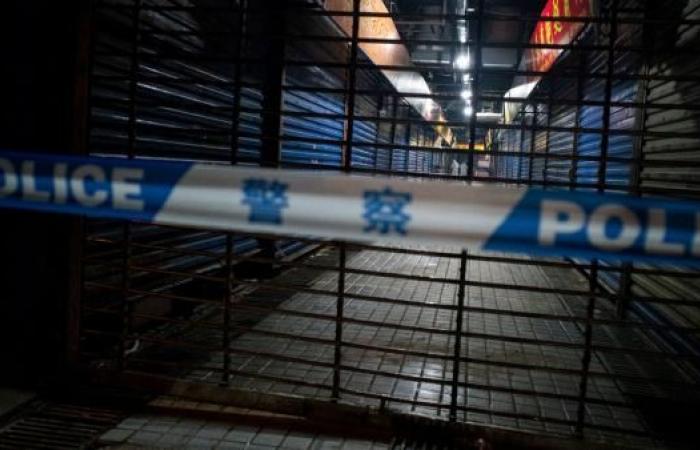Thank you for reading the news about Yemen in Focus: Yemeni students stranded in 'apocalyptic' Wuhan and now with the details
Aden - Yasmine El Tohamy - The students in Wuhan, widely deemed to be the city at the epicentre of the disease which broke out at an exotic animal market late December, have not yet received assistance from either Yemeni or Chinese authorities.
An alarming WhatsApp message purportedly sent by a young Yemeni woman in Wuhan details the frightening circumstances in the ghost city, which she compares to a scene from the apocalyptic Netflix blockbuster Bird Box.
"The cases are crazy – it is as if a fire is burning in the wild and we rot inside our homes. Soon we will finish all the food in our homes and attempting to leave the house in order to search for food is like a hunting trip in an empty forest," the message, seen by The New Arab, reads.
A number of Arab nations, including Saudi Arabia, Jordan, Syria, Oman, Tunisia, Bahrain and Palestine, have already flown their nationals out of China, which has faced severe global isolation since the novel virus broke out.
"Most of the students are here on government sponsorships but to this day, the government has not paid towards the student dues," one Yemeni student says in the AJ+ Arabic video.
"Who knows if these students can even pay to leave themselves," he adds.
Wuhan, the capital of China’s Hubei province, hosts some 11 million residents, all of whom have been placed under quarantine to help contain the spread of the disease.
Chinese authorities recently expanded the lockdown to an area covering some 50 million people, in a move praised by the World Health Organization [WHO].
"Chinese authorities have shut down airports, trains, metros and all modes of public transport in Wuhan," another stranded Yemeni says in the AJ+ Arabic clip.
The World Health Organization has already declared the outbreak a global emergency, and the Chinese death toll has risen to 4,722 while total infections reached over 20,000, surpassing the SARS epidemic two decades ago.
On Sunday the first foreign death from the virus was reported in the Philippines. Just a day later, Singapore confirmed the first local transmissions of the deadly coronavirus from China.
Following the spread of the damning AJ+ Arabic report online, Yemen’s ministry of foreign affairs confirmed in a tweet that it had made direct contact with the stranded students.
"We are in direct contact with our students in the city of Wuhan where the coronavirus has spread, and under the guidance of the state leadership we are coordinating with the Chinese authorities and our embassy in China to arrange the necessary procedures to provide what they [the students] need and discuss the possibility of evacuating them with the relevant authorities," the tweet said.
Read also: No, coronavirus won't turn you into a 'zombie', Malaysia says
No official contact was made, Yemeni students in Wuhan confirmed to The New Arab.
"The government has announced on social media that it will solve this issue, however nothing has since happened," a student told The New Arab.
"However, Yemen’s interior minister, Ahmed Al-Maysari has contacted one of the students and offered to personally evacuate the group of students if the government does not take the steps to do so," the student added.
More worryingly on the ground in Yemen, fears have grown after at least 95 Yemenis who fled China entered Yemen’s temporary capital Aden on Saturday, according to local reports.
The passengers, who flew out of China over fears of the deadly coronavirus outbreak, travelled via the Sudanese capital Khartoum on Yemen’s Al Saeeda Airlines, local Aden Alghad reported.
None of the passengers underwent medical tests on arrival at Aden International Airport on Saturday morning, the reports added, triggering fears over a potential outbreak in the war-torn country.
Yemen is already one of the most impoverished states in the Middle East, but its infrastructure has further deteriorated in the last five-years because of an ongoing conflict that pits the Houthi rebels against the government-backed Saudi-led coalition.
More than 100,000 people have already died since the war broke out in 2014 and exacerbated with the Saudi-led military intervention just months later in March 2015.
Yemen has not yet confirmed any cases of the coronavirus, which has since spread to more than 24 countries, despite many governments imposing unprecedented travel bans on people coming from China.
Mercy flights
Separately, Yemeni children in critical need of medical care were evacuated on Monday from the rebel-held capital Sanaa, in what the United Nations hopes will be the first of more mercy flights.
Seven young patients and their relatives flew out of Sanaa airport, which has been closed to commercial flights since 2016, aboard a UN-marked plane bound for Amman.
"This is the first of what we hope will be a number of flights in the medical air bridge," UN Resident Coordinator for Yemen Lise Grande told AFP, adding that more patients and their families would travel to Jordan and Egypt in coming days.
"It's crucially important that this first flight has gone," she said of the evacuation programme which took months to negotiate.
"All of us feel today that this is a major breakthrough and an indication of hope out of Yemen."
Yemen's internationally recognised government, backed by a Saudi-led military coalition, has been fighting Iran-backed Houthi rebels since 2014 when they seized control of the capital.
In November, the coalition – which controls Yemen's airspace – said patients needing medical care would be allowed to fly out of Sanaa.
Read more: Yemen in Focus: Sanaa airport opening 'too little, too late'
The move was among confidence-building measures aimed at ending the five-year war that has killed thousands of people and displaced millions in what the UN has termed the world's worst humanitarian crisis.
The launch of the "air bridge" is a rare bright spot in Yemen, and a possible step towards reopening Sanaa airport which is a key demand of the Houthis and one of the issues being pursued by UN-led mediators.
On Sunday, the Houthis criticised the plan as inadequate, saying as many as 32,000 patients with serious illnesses were waiting to sign up for medical evacuations.
A World Health Organization spokeswoman told AFP that three more flights have been scheduled for February 4, 5 and 7, bound for Amman and Cairo.
Patients awaiting evacuation include "women and children who suffer from conditions such as aggressive forms of cancer and brain tumours, or who need organ transplants and reconstructive surgeries," the WHO said in a tweet.
The Norwegian Refugee Council welcomed the start of the humanitarian airlift, saying thousands of Yemenis had been handed a "death sentence" when the coalition closed down Sanaa airport.
"Today's move comes too late for thousands of Yemenis who died waiting to leave the country for urgent life-saving care," said Mohamed Abdi, the NRC's country director for Yemen.
"We hope that these medical flights will save the lives of other Yemenis. Many more are still waiting to get the healthcare they need."
More than 30,000 people in need or urgent medical care abroad have died due to the lack of access to airports since commercial flights were grounded in 2016, according to ministry of health estimates.
Meanwhile, UN figures from 2017 showed some 20,000 had been denied access to potentially life-saving healthcare due to airspace restrictions.
In Yemen, only 51 percent of health facilities are fully functional and access to medication is scarce.
 | In Yemen, only 51% of health facilities are fully functional and access to medication is scarce |  |
The launch of the evacuations comes against a backdrop of a deterioration in Yemen's conflict, with fierce fighting around Sanaa that erupted after a period of relative calm.
AQAP's Al-Raymi killed
On Saturday, tribal leaders said a suspected US drone strike destroyed a building housing al-Qaeda militants last week in eastern Yemen.
US President Donald Trump, meanwhile, retweeted several tweets and media reports that seemed to offer confirmation the January 25 strike had killed top al-Qaeda leader Qasim al-Raymi. The CIA declined to comment.
The tribal leaders said the drone strike took place in the Wadi Ubaidah area in the eastern province of Marib. The area is known as a stronghold for al-Qaeda in the Arabian Peninsula, or AQAP, as the Yemeni affiliate is known.
They said at least three explosions rocked the area, and that the building was set ablaze.
It was not immediately clear how many militants were in the building at the time or their identities. The tribal leaders said a handful of al-Qaeda militants arrived at the area directly after the strike and cordoned off the area.
The tribal leaders spoke on condition of anonymity because they feared reprisals.
Al-Raymi succeeded Nasser al-Wahishi, who was killed in a US drone strike in 2015, as the top leader of AQAP.
Among Trump's retweets was a thread by Rita Katz, director of SITE Intelligence Group, which tracks messaging by militant groups. Katz said the attack took place January 25 and she began tweeting about it January 27.
"If true, and it seems to be, the death of al-Rimi would mark a major blow to #AlQaeda on the whole. Al-Rimi was a candidate for succeeding AQ leader Zawahiri," Katz tweeted on Thursday, using an alternative spelling for al-Raymi. She was referring to al-Qaeda chief Ayman al-Zawahiri.
Katz said that of all living al-Qaeda leaders, al-Raymi "was the most compelling, known for his charisma and beloved across the AQ community."
AQAP has long been considered the global network's most dangerous branch and has attempted to carry out attacks on the US mainland.
Iranian weapons
Also in Yemen this week, the UN revealed Yemen’s Houthi rebels are receiving parts for drones and weapons, some with technical characteristics similar to arms manufactured in Iran, in potential violation of a UN arms embargo.
The experts said in a report to the Security Council, obtained on Friday by The Associated Press, that the main smuggling route for both the commercially available drone parts and weapons "seems to run overland from Oman and the southern coast of Yemen, through territory controlled by the government of Yemen, towards Sanaa," the country’s capital, which is controlled by the Houthis.
The panel said the high-profile seizure of a dhow in the Arabian Sea on November 25 carrying anti-tank missiles indicates that sea transport also "continues to play a role" in potential violations of the arms embargo.
"Throughout 2019," the experts said, "the Houthis and the government of Yemen made little headway towards either a political settlement or a conclusive military victory.
"In a continuation from 2018, the belligerents continued to practice economic warfare: using economic obstruction and financial tools as weapons to starve opponents of funds or materials," the panel said, adding that "profiteering from the conflict is endemic."
In the Houthi-controlled north, the experts said, the rebels continued to consolidate their political and military control, using their "pervasive intelligence services" and brutally suppressing tribal opposition and political dissent.
The panel said it identified a network targeting women who oppose the Houthis, including through the use of sexual violence. In 11 cases, the experts said they documented the arrest, detention, beating, torture and/or sexual abuse of women "because of their political affiliations or participation in political activities or public protests."
"These women were threatened with charges of prostitution or organised crime if they persisted in activities against the Houthis," the panel said.
During most of 2019, the panel said, the Houthis continued and intensified aerial attacks on Saudi Arabia using two new weapon systems – a new type of unmanned Delta-design drone and a new land attack cruise missile model.
The experts said they investigated the September 14 high-profile attack on Saudi Aramco oil facilities in Khurays and Abqaiq, where the kingdom’s crucial oil processing plant is. The drone and missile attacks cut into global energy supplies and halved Saudi oil production.
The Houthis claimed responsibility for the attacks. But the panel said it found that "despite claims to the contrary, the Houthi forces are unlikely to be responsible for the attack, as the estimated range of the weapon systems used does not allow for a launch from Houthi-controlled territory."
Nonetheless, the experts said a number of other attacks using the same drones and land-based cruise missiles can be attributed to the Houthis.
The United States has alleged that Iran was responsible for the Aramco attacks. Tehran called the US claims "maximum lies."
The panel said it did not believe the comparatively sophisticated weapons used in those attacks "were developed and manufactured in Yemen, implying that they were imported in violation of the targeted arms embargo."
The panel said it has analysed debris from drones and seized parts, and traced one consignment from a Hong Kong company to an address in Muscat, Oman, and another from Japan to Abu Dhabi.
Yemen In Focus is a regular feature from The New Arab.
Sana Uqba is a journalist at The New Arab.
Follow her on Twitter: @Sanasiino
These were the details of the news Yemen in Focus: Yemeni students stranded in 'apocalyptic' Wuhan for this day. We hope that we have succeeded by giving you the full details and information. To follow all our news, you can subscribe to the alerts system or to one of our different systems to provide you with all that is new.
It is also worth noting that the original news has been published and is available at The New Arab and the editorial team at AlKhaleej Today has confirmed it and it has been modified, and it may have been completely transferred or quoted from it and you can read and follow this news from its main source.







